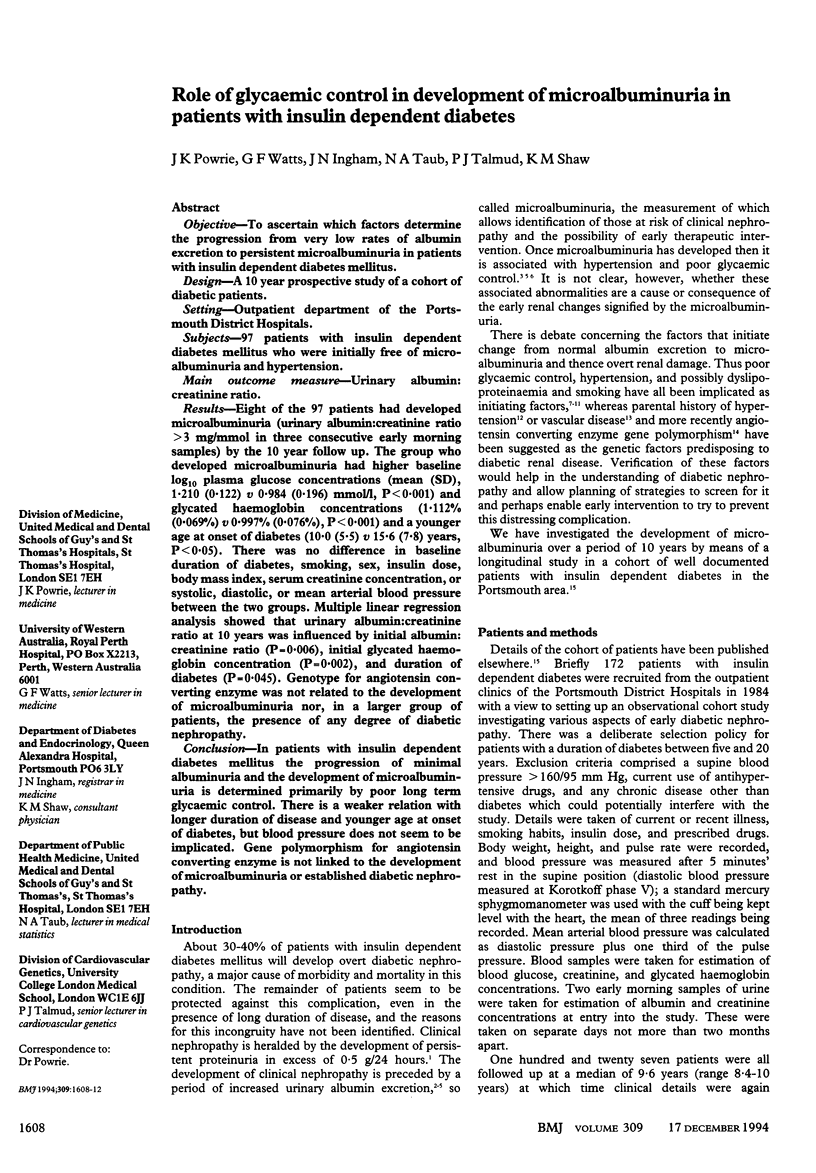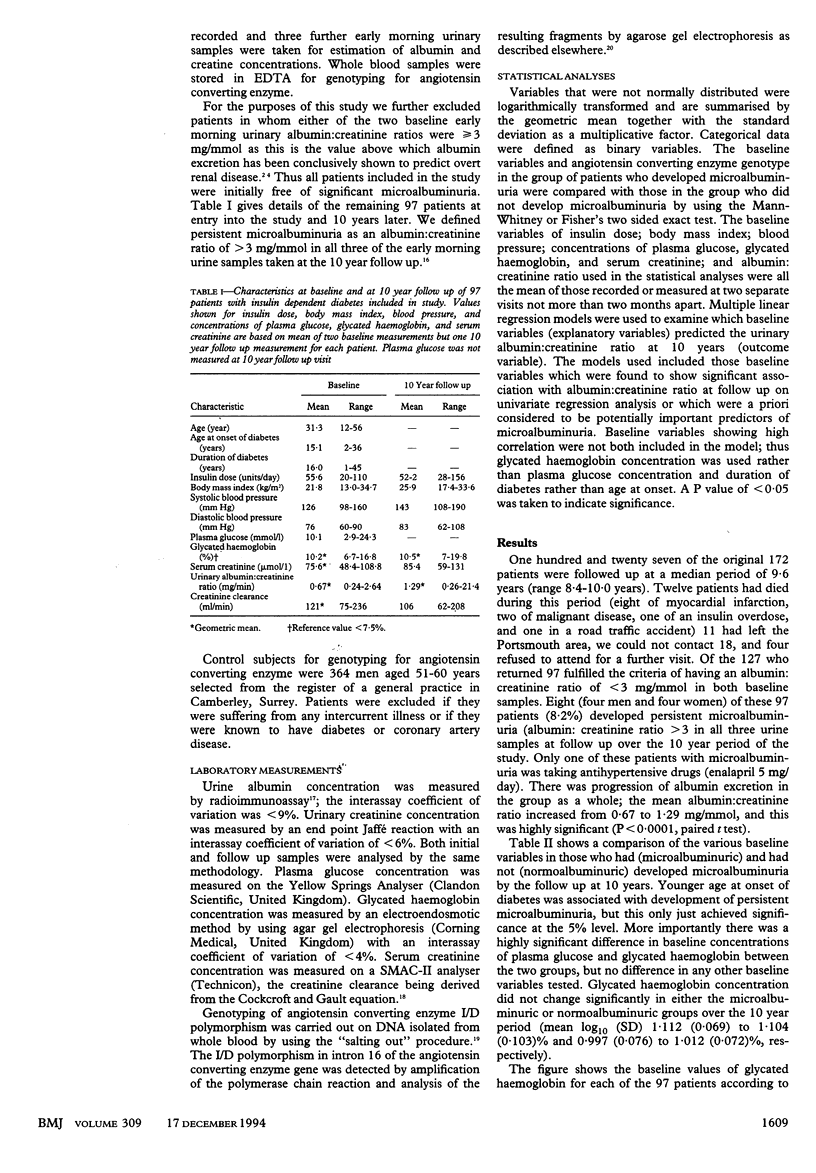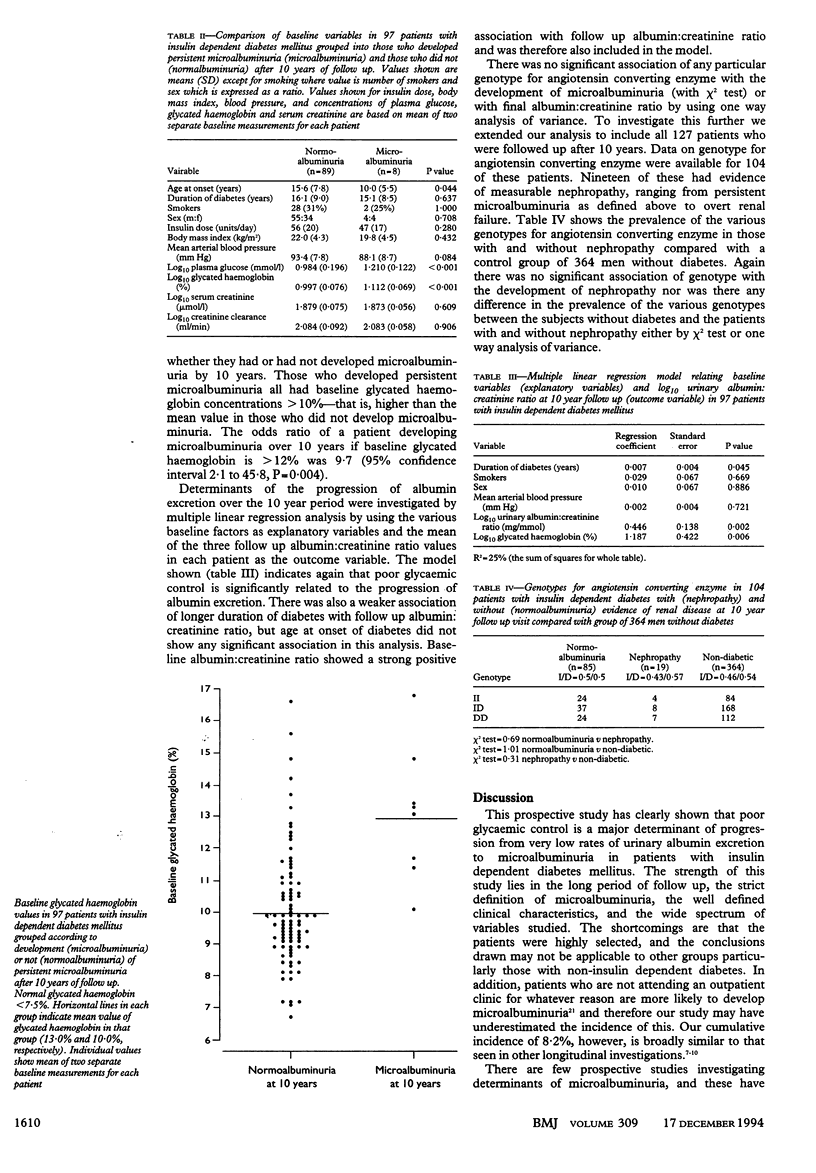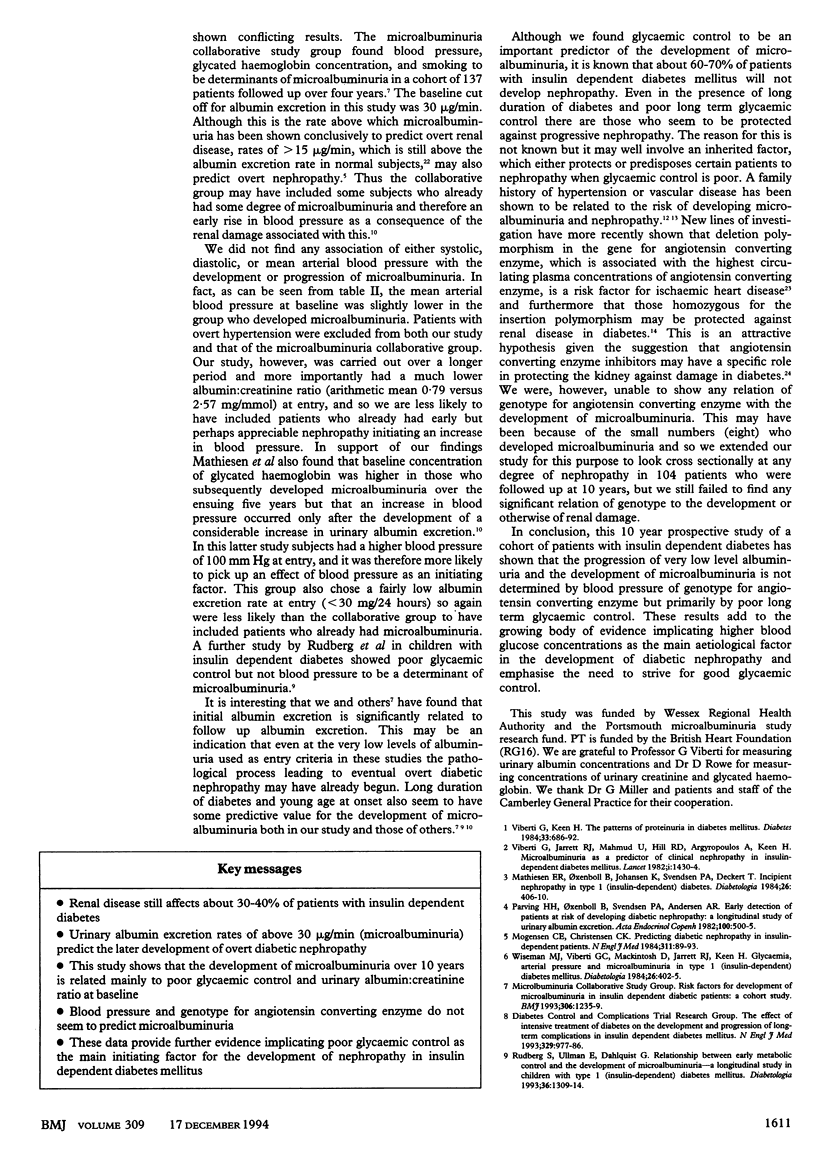Abstract
OBJECTIVE--To ascertain which factors determine the progression from very low rates of albumin excretion to persistent microalbuminuria in patients with insulin dependent diabetes mellitus. DESIGN--A 10 year prospective study of a cohort of diabetic patients. SETTING--Outpatient department of the Portsmouth District Hospitals. SUBJECTS--97 patients with insulin dependent diabetes mellitus who were initially free of microalbuminuria and hypertension. MAIN OUTCOME MEASURE--Urinary albumin: creatinine ratio. RESULTS--Eight of the 97 patients had developed microalbuminuria (urinary albumin:creatinine ratio > 3 mg/mmol in three consecutive early morning samples) by the 10 year follow up. The group who developed microalbuminuria had higher baseline log10 plasma glucose concentrations (mean (SD), 1.210 (0.122) v 0.984 (0.196) mmol/l, P < 0.001) and glycated haemoglobin concentrations (1.112% (0.069%) v 0.997% (0.076%), P < 0.001) and a younger age at onset of diabetes (10.0 (5.5) v 15.6 (7.8) years, P < 0.05). There was no difference in baseline duration of diabetes, smoking, sex, insulin dose, body mass index, serum creatinine concentration, or systolic, diastolic, or mean arterial blood pressure between the two groups. Multiple linear regression analysis showed that urinary albumin:creatinine ratio at 10 years was influenced by initial albumin:creatinine ratio (P = 0.006), initial glycated haemoglobin concentration (P = 0.002), and duration of diabetes (P = 0.045). Genotype for angiotensin converting enzyme was not related to the development of microalbuminuria nor, in a larger group of patients, the presence of any degree of diabetic nephropathy. CONCLUSION--In patients with insulin dependent diabetes mellitus the progression of minimal albuminuria and the development of microalbuminuria is determined primarily by poor long term glycaemic control. There is a weaker relation with longer duration of disease and younger age at onset of diabetes, but blood pressure does not seem to be implicated. Gene polymorphism for angiotensin converting enzyme is not linked to the development of microalbuminuria or established diabetic nephropathy.
Full text
PDF




Selected References
These references are in PubMed. This may not be the complete list of references from this article.
- Cambien F., Poirier O., Lecerf L., Evans A., Cambou J. P., Arveiler D., Luc G., Bard J. M., Bara L., Ricard S. Deletion polymorphism in the gene for angiotensin-converting enzyme is a potent risk factor for myocardial infarction. Nature. 1992 Oct 15;359(6396):641–644. doi: 10.1038/359641a0. [DOI] [PubMed] [Google Scholar]
- Cockcroft D. W., Gault M. H. Prediction of creatinine clearance from serum creatinine. Nephron. 1976;16(1):31–41. doi: 10.1159/000180580. [DOI] [PubMed] [Google Scholar]
- Earle K., Walker J., Hill C., Viberti G. Familial clustering of cardiovascular disease in patients with insulin-dependent diabetes and nephropathy. N Engl J Med. 1992 Mar 5;326(10):673–677. doi: 10.1056/NEJM199203053261005. [DOI] [PubMed] [Google Scholar]
- Krolewski A. S., Warram J. H., Christlieb A. R., Busick E. J., Kahn C. R. The changing natural history of nephropathy in type I diabetes. Am J Med. 1985 May;78(5):785–794. doi: 10.1016/0002-9343(85)90284-0. [DOI] [PubMed] [Google Scholar]
- Marre M., Bernadet P., Gallois Y., Savagner F., Guyene T. T., Hallab M., Cambien F., Passa P., Alhenc-Gelas F. Relationships between angiotensin I converting enzyme gene polymorphism, plasma levels, and diabetic retinal and renal complications. Diabetes. 1994 Mar;43(3):384–388. doi: 10.2337/diab.43.3.384. [DOI] [PubMed] [Google Scholar]
- Marre M., Chatellier G., Leblanc H., Guyene T. T., Menard J., Passa P. Prevention of diabetic nephropathy with enalapril in normotensive diabetics with microalbuminuria. BMJ. 1988 Oct 29;297(6656):1092–1095. doi: 10.1136/bmj.297.6656.1092. [DOI] [PMC free article] [PubMed] [Google Scholar]
- Mathiesen E. R., Oxenbøll B., Johansen K., Svendsen P. A., Deckert T. Incipient nephropathy in type 1 (insulin-dependent) diabetes. Diabetologia. 1984 Jun;26(6):406–410. doi: 10.1007/BF00262210. [DOI] [PubMed] [Google Scholar]
- Mathiesen E. R., Rønn B., Jensen T., Storm B., Deckert T. Relationship between blood pressure and urinary albumin excretion in development of microalbuminuria. Diabetes. 1990 Feb;39(2):245–249. doi: 10.2337/diab.39.2.245. [DOI] [PubMed] [Google Scholar]
- Miller S. A., Dykes D. D., Polesky H. F. A simple salting out procedure for extracting DNA from human nucleated cells. Nucleic Acids Res. 1988 Feb 11;16(3):1215–1215. doi: 10.1093/nar/16.3.1215. [DOI] [PMC free article] [PubMed] [Google Scholar]
- Mogensen C. E., Christensen C. K. Predicting diabetic nephropathy in insulin-dependent patients. N Engl J Med. 1984 Jul 12;311(2):89–93. doi: 10.1056/NEJM198407123110204. [DOI] [PubMed] [Google Scholar]
- Rigat B., Hubert C., Alhenc-Gelas F., Cambien F., Corvol P., Soubrier F. An insertion/deletion polymorphism in the angiotensin I-converting enzyme gene accounting for half the variance of serum enzyme levels. J Clin Invest. 1990 Oct;86(4):1343–1346. doi: 10.1172/JCI114844. [DOI] [PMC free article] [PubMed] [Google Scholar]
- Rudberg S., Ullman E., Dahlquist G. Relationship between early metabolic control and the development of microalbuminuria--a longitudinal study in children with type 1 (insulin-dependent) diabetes mellitus. Diabetologia. 1993 Dec;36(12):1309–1314. doi: 10.1007/BF00400811. [DOI] [PubMed] [Google Scholar]
- Viberti G. C., Hill R. D., Jarrett R. J., Argyropoulos A., Mahmud U., Keen H. Microalbuminuria as a predictor of clinical nephropathy in insulin-dependent diabetes mellitus. Lancet. 1982 Jun 26;1(8287):1430–1432. doi: 10.1016/s0140-6736(82)92450-3. [DOI] [PubMed] [Google Scholar]
- Viberti G. C., Keen H., Wiseman M. J. Raised arterial pressure in parents of proteinuric insulin dependent diabetics. Br Med J (Clin Res Ed) 1987 Aug 29;295(6597):515–517. doi: 10.1136/bmj.295.6597.515. [DOI] [PMC free article] [PubMed] [Google Scholar]
- Viberti G., Keen H. The patterns of proteinuria in diabetes mellitus. Relevance to pathogenesis and prevention of diabetic nephropathy. Diabetes. 1984 Jul;33(7):686–692. doi: 10.2337/diab.33.7.686. [DOI] [PubMed] [Google Scholar]
- Watts G. F., Bennett J. E., Rowe D. J., Morris R. W., Gatling W., Shaw K. M., Polak A. Assessment of immunochemical methods for determining low concentrations of albumin in urine. Clin Chem. 1986 Aug;32(8):1544–1548. [PubMed] [Google Scholar]
- Watts G. F., Harris R., Shaw K. M. The determinants of early nephropathy in insulin-dependent diabetes mellitus: a prospective study based on the urinary excretion of albumin. Q J Med. 1991 Apr;79(288):365–378. [PubMed] [Google Scholar]
- Watts G. F., Kubal C., Chinn S. Long-term variation of urinary albumin excretion in insulin-dependent diabetes mellitus: some practical recommendations for monitoring microalbuminuria. Diabetes Res Clin Pract. 1990 May-Jun;9(2):169–177. doi: 10.1016/0168-8227(90)90109-7. [DOI] [PubMed] [Google Scholar]
- Watts G. F., Morris R. W., Khan K., Polak A. Urinary albumin excretion in healthy adult subjects: reference values and some factors affecting their interpretation. Clin Chim Acta. 1988 Mar 15;172(2-3):191–198. doi: 10.1016/0009-8981(88)90323-3. [DOI] [PubMed] [Google Scholar]
- Watts G. F., Naumova R., Slavin B. M., Morris R. W., Houlston R., Kubal C., Shaw K. M. Serum lipids and lipoproteins in insulin-dependent diabetic patients with persistent microalbuminuria. Diabet Med. 1989 Jan-Feb;6(1):25–30. doi: 10.1111/j.1464-5491.1989.tb01134.x. [DOI] [PubMed] [Google Scholar]


